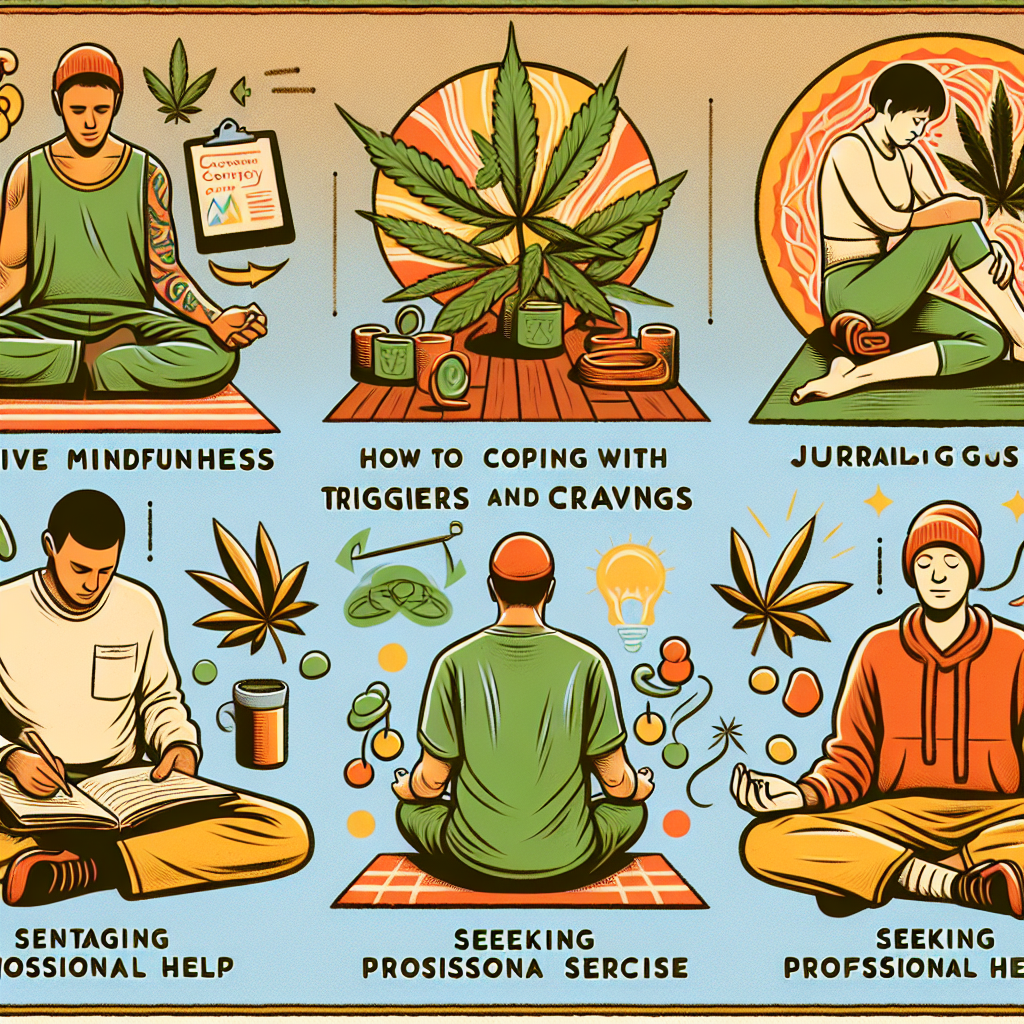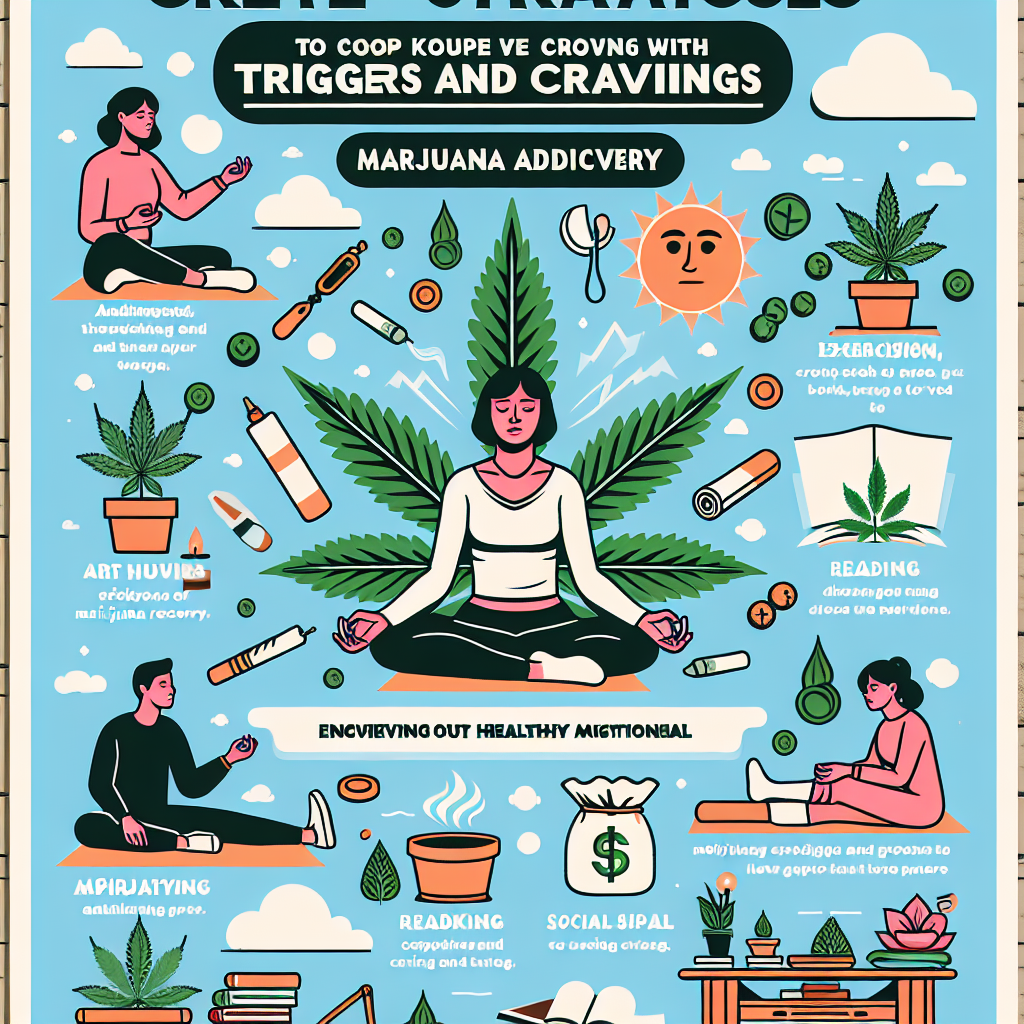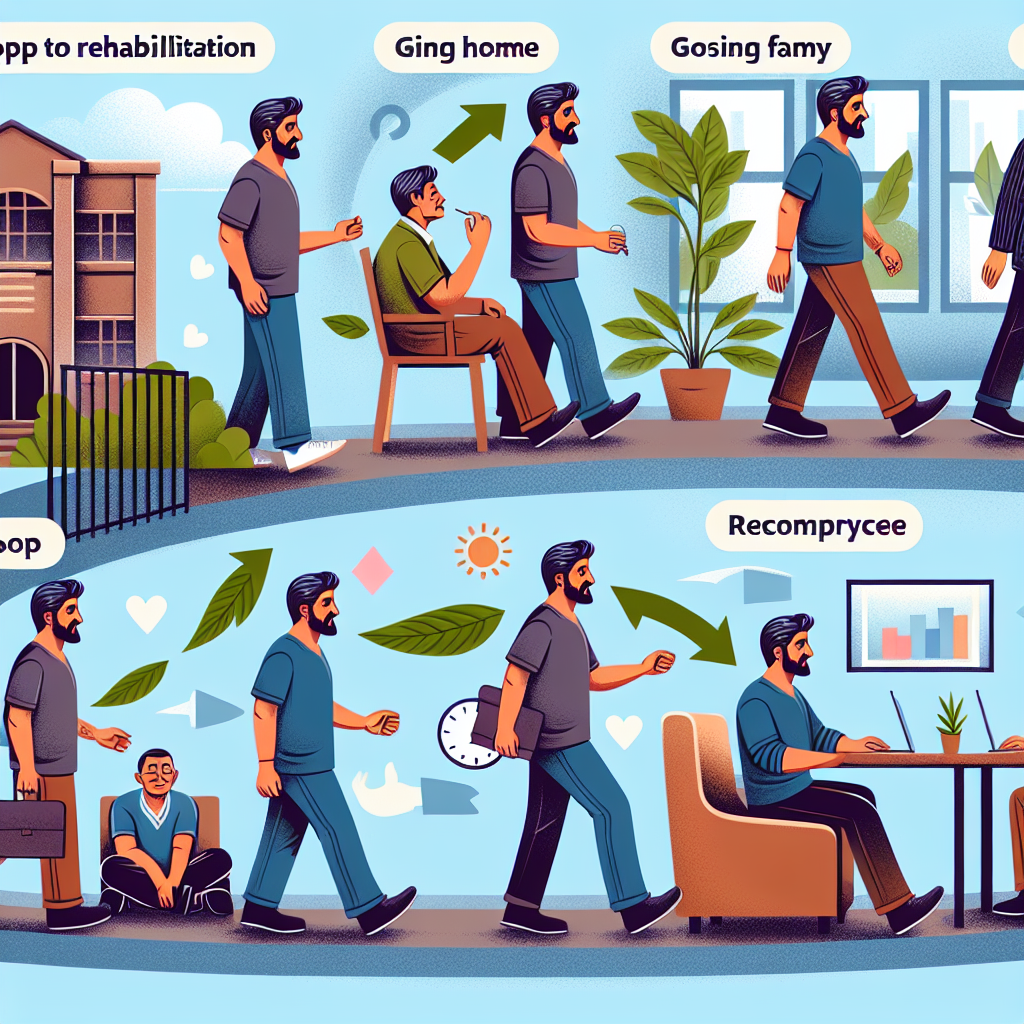-
Table of Contents
“Empower Your Journey: Mastering Triggers and Cravings in Marijuana Recovery”
Introduction

Marijuana addiction recovery can be a challenging journey, often marked by the presence of triggers and cravings that can jeopardize progress. Understanding how to effectively handle these triggers and cravings is crucial for maintaining sobriety and achieving long-term recovery. This involves recognizing the specific situations, emotions, or environments that may prompt the desire to use marijuana, and developing strategies to cope with these urges. Techniques such as mindfulness, cognitive-behavioral strategies, support groups, and lifestyle changes can play a significant role in managing these challenges. By equipping oneself with the right tools and support systems, individuals can navigate the complexities of recovery and work towards a healthier, substance-free life.
Identifying and Understanding Your Triggers
In the journey of marijuana addiction recovery, identifying and understanding your triggers is a crucial step towards long-term success. Triggers are specific situations, emotions, or environments that prompt the urge to use marijuana. Recognizing these triggers can empower you to develop strategies to manage them effectively, thereby reducing the risk of relapse. To begin with, it is essential to acknowledge that triggers can be both internal and external. Internal triggers often stem from emotions such as stress, anxiety, or boredom, while external triggers might include social settings, certain people, or specific locations associated with past use.
One of the first steps in identifying your triggers is to keep a detailed journal. Documenting your daily experiences, emotions, and cravings can help you pinpoint patterns and specific circumstances that lead to the desire to use marijuana. For instance, you might notice that you crave marijuana more intensely after a stressful day at work or when you are around certain friends. By writing these observations down, you create a tangible record that can be analyzed and used to develop coping strategies.
Moreover, understanding your triggers involves a deep dive into your emotional landscape. Often, marijuana use is a way to cope with underlying emotional issues. Reflecting on your feelings and the reasons behind your cravings can provide valuable insights. Are you using marijuana to escape from feelings of inadequacy, loneliness, or depression? Identifying these emotional triggers allows you to address the root cause of your addiction rather than just the symptoms.
In addition to self-reflection, seeking support from a therapist or counselor can be incredibly beneficial. A professional can help you explore your triggers in a safe and structured environment, offering guidance and tools to manage them. Cognitive-behavioral therapy (CBT), for example, is a highly effective approach that helps individuals recognize and change negative thought patterns and behaviors associated with their addiction.
Furthermore, it is important to develop a robust support system. Surrounding yourself with understanding and supportive individuals can make a significant difference in your recovery journey. Friends, family, or support groups can provide encouragement and accountability, helping you stay on track when faced with triggers. Sharing your experiences and challenges with others who have gone through similar struggles can also offer a sense of camaraderie and motivation.
Once you have identified your triggers, the next step is to develop coping strategies. This might involve finding healthy alternatives to manage stress and emotions, such as exercise, meditation, or engaging in hobbies that bring you joy. Additionally, learning to set boundaries and avoid high-risk situations can prevent exposure to external triggers. For example, if social gatherings with certain friends lead to cravings, it might be necessary to limit your time with them or suggest alternative activities that do not involve marijuana.
In conclusion, identifying and understanding your triggers is a foundational aspect of marijuana addiction recovery. By keeping a journal, reflecting on your emotions, seeking professional support, and building a strong support system, you can gain valuable insights into the factors that drive your cravings. Developing effective coping strategies and making conscious choices to avoid high-risk situations will empower you to navigate your recovery journey with resilience and determination. Remember, recovery is a process, and each step you take towards understanding and managing your triggers brings you closer to a healthier, marijuana-free life.
Developing Healthy Coping Mechanisms
In the journey of marijuana addiction recovery, developing healthy coping mechanisms is crucial for long-term success. Triggers and cravings can be formidable obstacles, but with the right strategies, they can be managed effectively. Understanding the nature of these challenges is the first step toward overcoming them. Triggers are external or internal cues that prompt the desire to use marijuana, while cravings are the intense urges that follow. Both can be powerful, but they are not insurmountable.
One of the most effective ways to handle triggers and cravings is through mindfulness and self-awareness. By paying close attention to your thoughts and feelings, you can identify the specific triggers that lead to cravings. This awareness allows you to anticipate and prepare for these moments, reducing their impact. For instance, if social situations are a trigger, you might choose to avoid certain gatherings or have a plan in place to manage your response. Mindfulness practices, such as meditation and deep-breathing exercises, can help you stay grounded and focused, making it easier to navigate challenging moments.
Another essential strategy is to build a strong support network. Surrounding yourself with people who understand your journey and can offer encouragement and accountability is invaluable. This network can include friends, family, support groups, or a therapist. Sharing your experiences and challenges with others who have faced similar struggles can provide comfort and insight. Additionally, having someone to call or meet with when cravings strike can be a powerful deterrent against relapse.
Engaging in healthy activities is also a key component of developing coping mechanisms. Physical exercise, for example, can be a great way to manage stress and reduce cravings. Exercise releases endorphins, which are natural mood lifters, and can help distract you from the urge to use marijuana. Whether it’s running, swimming, yoga, or any other form of physical activity, finding something you enjoy can make a significant difference in your recovery process.
Moreover, finding new hobbies and interests can fill the void left by marijuana use. Creative outlets such as painting, writing, or playing a musical instrument can provide a sense of accomplishment and joy. These activities not only occupy your time but also help you discover new passions and talents. Engaging in activities that bring you pleasure and fulfillment can reduce the temptation to revert to old habits.
It’s also important to establish a routine that supports your recovery. Consistency can provide a sense of stability and predictability, which can be comforting during times of uncertainty. A well-structured daily schedule that includes time for self-care, work, social activities, and relaxation can help you stay focused and motivated. By creating a balanced routine, you can reduce the likelihood of encountering triggers and increase your resilience against cravings.
Lastly, practicing self-compassion is vital. Recovery is a journey with ups and downs, and it’s essential to be kind to yourself throughout the process. Acknowledge your progress, no matter how small, and understand that setbacks are a natural part of recovery. Instead of dwelling on mistakes, use them as learning opportunities to strengthen your coping mechanisms. By treating yourself with patience and understanding, you can maintain a positive outlook and stay committed to your recovery goals.
In conclusion, handling triggers and cravings in marijuana addiction recovery requires a multifaceted approach. By cultivating mindfulness, building a support network, engaging in healthy activities, establishing a routine, and practicing self-compassion, you can develop effective coping mechanisms that support your long-term success. Remember, every step you take toward recovery is a step toward a healthier, more fulfilling life.
Building a Support Network
Building a support network is a crucial step in handling triggers and cravings during marijuana addiction recovery. The journey to sobriety is often fraught with challenges, and having a strong support system can make a significant difference in navigating these obstacles. One of the first steps in building this network is to identify individuals who can offer encouragement, understanding, and accountability. These individuals can be family members, friends, or even colleagues who are supportive of your recovery journey. It is essential to communicate openly with them about your goals and the specific ways they can assist you.
In addition to personal connections, joining support groups can provide a sense of community and shared experience. Groups such as Marijuana Anonymous (MA) offer a safe space to discuss struggles and successes with others who are on a similar path. These groups often follow a structured program that includes regular meetings, which can help establish a routine and provide consistent support. The shared experiences within these groups can be incredibly validating and can help reduce feelings of isolation.
Professional help is another critical component of a robust support network. Therapists and counselors who specialize in addiction recovery can offer personalized strategies to manage triggers and cravings. Cognitive-behavioral therapy (CBT), for example, is a common approach that helps individuals identify and change negative thought patterns that contribute to substance use. Working with a professional can also provide a confidential space to explore underlying issues that may be driving the addiction.
Moreover, online resources and communities can be invaluable, especially for those who may not have access to in-person support groups. Websites, forums, and social media groups dedicated to marijuana addiction recovery can offer advice, share success stories, and provide a platform for asking questions. These online communities can be particularly helpful in moments of immediate need, offering real-time support and connection.
Building a support network also involves setting boundaries with individuals who may not be supportive of your recovery. This can be challenging, especially if these individuals are close friends or family members. However, it is crucial to prioritize your well-being and recovery. Communicating your needs clearly and assertively can help establish these boundaries. In some cases, it may be necessary to distance yourself from certain relationships temporarily or permanently if they are detrimental to your recovery.
Incorporating healthy activities into your routine can also play a significant role in managing triggers and cravings. Engaging in physical exercise, pursuing hobbies, and practicing mindfulness techniques such as meditation or yoga can provide positive outlets for stress and anxiety. These activities can also help build new, healthy habits that replace the time and energy previously spent on substance use.
Lastly, it is important to celebrate milestones and progress, no matter how small they may seem. Recovery is a long-term process, and acknowledging achievements can boost motivation and self-esteem. Sharing these successes with your support network can also strengthen these relationships and provide additional encouragement.
In conclusion, building a support network is an essential strategy for handling triggers and cravings in marijuana addiction recovery. By surrounding yourself with supportive individuals, seeking professional help, engaging in healthy activities, and setting clear boundaries, you can create a strong foundation for lasting sobriety. Remember, recovery is a journey, and having a robust support system can make all the difference in achieving and maintaining a drug-free life.
Utilizing Mindfulness and Meditation Techniques
In the journey of marijuana addiction recovery, handling triggers and cravings can be one of the most challenging aspects. However, utilizing mindfulness and meditation techniques can provide a powerful toolkit to navigate these turbulent waters. By fostering a deeper awareness of the present moment and cultivating a non-judgmental attitude towards one’s thoughts and feelings, individuals can develop resilience and inner peace, which are essential for long-term recovery.
Mindfulness, at its core, is about paying attention to the present moment without judgment. This practice can be particularly beneficial for those in recovery, as it helps to break the automatic response to triggers and cravings. When a craving arises, instead of reacting impulsively, mindfulness encourages individuals to observe the craving with curiosity and without immediate action. This pause creates a space where one can make a conscious choice rather than falling into old patterns of behavior.
Meditation, a key component of mindfulness, offers a structured way to cultivate this awareness. Regular meditation practice can help individuals become more attuned to their thoughts and emotions, making it easier to recognize the early signs of a craving. For instance, a simple breathing meditation can be incredibly effective. By focusing on the breath, individuals can anchor themselves in the present moment, reducing the power of the craving. As they breathe in and out, they can observe the craving as a passing sensation, rather than something that must be acted upon immediately.
Moreover, body scan meditation can also be a valuable tool. This technique involves mentally scanning the body from head to toe, noticing any areas of tension or discomfort. By bringing attention to these physical sensations, individuals can often uncover underlying emotions or stressors that may be contributing to their cravings. Addressing these root causes can be a crucial step in managing and ultimately reducing the frequency and intensity of cravings.
In addition to these meditation practices, incorporating mindfulness into daily activities can further support recovery. Simple actions like mindful eating, where one pays full attention to the taste, texture, and smell of food, or mindful walking, where one focuses on the sensation of each step, can reinforce the habit of staying present. These practices not only provide a break from the constant stream of thoughts but also help to build a more mindful approach to life in general.
Furthermore, mindfulness and meditation can enhance emotional regulation, which is often a significant challenge in addiction recovery. By regularly practicing these techniques, individuals can develop a greater capacity to handle difficult emotions without resorting to marijuana use. For example, when feelings of anxiety or sadness arise, instead of seeking relief through substances, one can turn to mindfulness practices to process these emotions in a healthy way.
It is also important to recognize that mindfulness and meditation are skills that require practice and patience. The benefits may not be immediate, but with consistent effort, individuals can experience profound changes in their ability to handle triggers and cravings. Support from a community, whether through meditation groups or recovery programs that incorporate mindfulness, can also provide encouragement and accountability.
In conclusion, utilizing mindfulness and meditation techniques can be a transformative approach in managing triggers and cravings in marijuana addiction recovery. By fostering a present-moment awareness and a non-judgmental attitude, individuals can develop the resilience needed to navigate their recovery journey. Through regular practice, these techniques can help build a foundation of inner peace and emotional stability, paving the way for a healthier, substance-free life.
Q&A
1. **What are some effective strategies for managing triggers in marijuana addiction recovery?**
– Identify and avoid triggers, practice mindfulness and relaxation techniques, engage in physical activities, and seek support from a therapist or support group.
2. **How can mindfulness help in handling cravings for marijuana?**
– Mindfulness helps by increasing awareness of cravings without acting on them, allowing individuals to observe their thoughts and feelings non-judgmentally and reduce the intensity of the craving.
3. **What role does physical exercise play in managing marijuana cravings?**
– Physical exercise releases endorphins, reduces stress, improves mood, and provides a healthy distraction from cravings, making it easier to resist the urge to use marijuana.
4. **Why is it important to have a support system during marijuana addiction recovery?**
– A support system provides emotional encouragement, accountability, shared experiences, and practical advice, which can significantly enhance the ability to cope with triggers and maintain sobriety.
Conclusion
Effectively handling triggers and cravings in marijuana addiction recovery involves a multifaceted approach that includes identifying and avoiding triggers, developing healthy coping mechanisms, seeking support from therapy or support groups, and maintaining a structured routine. Mindfulness practices, such as meditation and deep breathing exercises, can help manage stress and reduce cravings. Additionally, engaging in physical activities and hobbies can provide positive distractions. Consistent self-reflection and setting realistic goals are crucial for long-term success. Overall, a combination of self-awareness, support systems, and healthy lifestyle choices is essential for overcoming triggers and cravings in marijuana addiction recovery.



